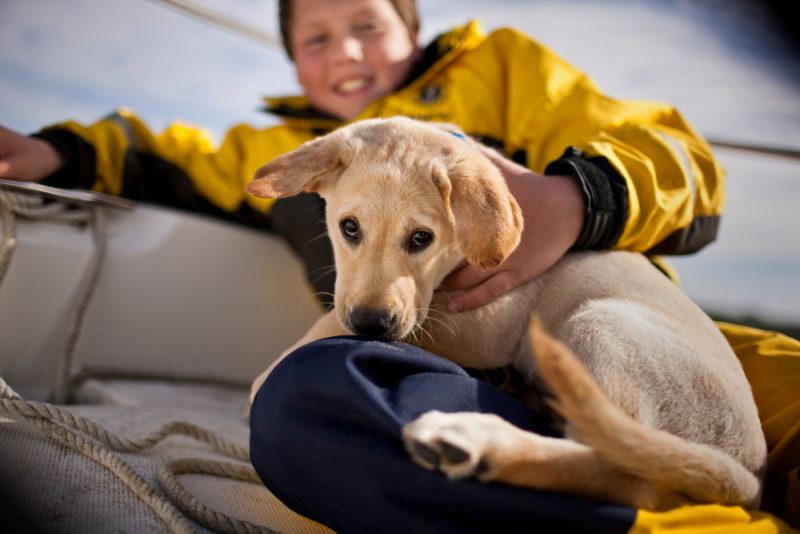Do Dogs Get Seasick? Vet-Verified Causes, Signs & Helpful Tips

Many dogs enjoy swimming and going on boat rides. However, it’s important to remember that some dogs can feel seasick if they’re on a boat. Therefore, it’s important to keep an eye on your dog and look for signs of seasickness, especially if it’s their first time riding a boat. We’ll go over the signs of seasickness in dogs and provide tips on how to help your dog if they’re feeling seasick.


Causes of Seasickness in Dogs
Seasickness, or motion sickness, is fairly common in dogs, especially if they haven’t grown up riding on boats and being on the water. Motion sickness occurs when the sensory organ in the inner ear is overstimulated. This triggers the vomiting center in the brain stem and causes dogs to feel sick. Seasickness can also be associated with anxiety or stress.
Younger dogs are more likely to get seasick than older dogs. Dogs under 1 year old have parts of the ear that aren’t fully developed yet, and this can make them more prone to seasickness. Many dogs can outgrow seasickness and usually won’t feel it once they reach adulthood.
Sometimes, dogs can have a stressful first experience in a boat and get seasick. Because of this negative first experience, they may develop anxiety about riding a boat. This nervousness can cause them to feel seasick every time they get on a boat, even when they become adults.
Another cause of seasickness in dogs is a pre-existing medical condition. Dogs that have ear infections or vestibular disease can be more sensitive and get seasick more easily than other dogs.


Signs Your Dog Is Seasick
Nausea is the sign that’s most commonly associated with seasickness. However, nausea in dogs can look different from nausea in humans. Dogs who feel nauseous often lick or smack their lips frequently, and they look like they’re taking big gulps of air.
Dogs experiencing seasickness can also start to whine or pace around restlessly. They can start to drool or even vomit. Some dogs will appear more lethargic or inactive.
Because seasickness can look different from dog to dog, it’s best to be observant of your dog’s behavior while they’re on a boat versus when they’re on land. Be on the lookout for any significant behavioral shifts, especially signs of anxiety and nervousness. These are good indicators that your dog is starting to experience seasickness.


The 4 Ways to Help Dogs That Get Seasick
There are several things you can do to help dogs with seasickness.
1. Expose Them to Boats Gradually
It’s helpful to expose your dog to riding on boats gradually. Starting off with a long boat ride can feel overwhelming for dogs and increase the likelihood that they have a negative experience. It’s more beneficial for dogs to first get used to stepping into a boat and walking around while it’s stationary. You can use treats to make your dog’s first time on a boat a positive experience.
Once your dog gets comfortable walking around in a boat, you can take them out for a short boat ride that lasts between 5 to 10 minutes. Pay attention to their comfort level and gradually increase the amount of time your dog is on a boat until they feel completely comfortable.


2. Secure Them
Some dogs feel safer when they’re in a crate or attached to a harness. Crates can feel like a safe space for dogs, and they’ll welcome the option of retreating to a familiar place if they’re feeling uncomfortable or nervous. Being attached to a harness can give additional stability when a dog is sitting or standing, especially if the waves are particularly strong, potentially decreasing a dog’s nausea.
3. Refrain from Feeding Before Boat Rides
It’s often helpful to refrain from feeding your dog before you go on a boat. If your dog eats just before a boat ride, they may get nauseous more easily and vomit. Therefore, it’s best to wait at least an hour after your dog eats before you take them on a boat.
4. Medication
You can take a preventative approach by using over-the-counter anti-nausea medication. Just make sure to consult your veterinarian to ensure you give your dog the right medication and the proper dosage that’s safe for them to consume.


Conclusion
It can take dogs extra time to get used to riding on boats. Therefore, make sure to create positive experiences for your dog whenever they’re on a boat to reduce the risk of seasickness. Keep initial boat rides short, and try to create a comfortable resting space for your dog by using blankets, toys, and other familiar items. Lastly, you can also ask your veterinarian for information on medication that can help your dog feel calm and prevent nausea when they’re on a boat.
Featured Image Credit: Erickson Stock, Shutterstock



